![]()
NEW PRODUCT AND SERVICE OFFERINGS
BY COMMUNITY BANKS BY M. E. BOND


M. E. Bond mebond@memphis.edu is a professor at the Fogelman College of Business and Economics, The University of Memphis.
On November 12, 1999, the 106th U.S. Congress passed and the President signed into law Public Law 106-102. Its title was the Gramm-Leach-Bliley Act (also known as the Financial Modernization Act of 1999). Some of the provisions of the Act were tailored for large bank holding companies. Others, which provide them with new opportunities, were aimed at smaller community banks. This article reviews the major features of the Act with emphasis on the opportunities for community banks and presents the results of an empirical examination of community bankers' plans. Summarized in it are the findings of an original survey research conducted during the summer 2000. |
THE ACT
The major provisions of the Gramm-Leach-Bliley Act are shown in Table I (below), which lists each section of this act. These provisions open the opportunity for considerable modification of community bank operations. Community bankers have been restrained for years with regard to product diversification and geographic diversification. Broad scale implementation of either product or service diversification initiated during the past decade by many major bank holding companies has not been a possibility for many community bankers. Intrastate branching and interstate branching were both slower to be realized by community bankers than in the case of the larger holding company bankers. This demonstrates community bankers competitive disadvantage.
TABLE I
SYNOPSIS OF THE GRAMM-LEACH-BLILEY ACT OF 1999
SOURCE: "Financial Services Modernization: Analysis of the Gramm-Leach-Bliley Act of 1999," (Lexis Publishing, 2000).
The Act includes numerous changes that will impact banks. The provisions that are expected to have the greatest impact on the future operations of community banks are listed below.
SURVEY RESEARCH AND RESULTS
THE SURVEY
During the summer, 2000, in cooperation with the Arkansas Community Bankers Association, the Missouri Independent Bankers Association, and the Community Bankers Association of Indiana, Inc., a survey instrument was distributed to the members of each organization. The survey was to ascertain the perceptions of community bankers regarding plans for implementing new product and service offerings. The selection of the states was voluntary. Only three states were surveyed used for two reasons. First, budgeted resources limited the direct expenditures for the research. The three associations agreed to handle notification and distribution expenses for the research. Second, community banks (generally defined as those with $500 million or less in footings) were perceived to be quite similar one to another regardless of location. Therefore, a research objective was to obtain a sizeable number of replies from the three-state area and from the responses make generalized conclusions about community bankers plans following the passage of the Act.
Respondents were assured of anonymity. No questionnaires were coded or otherwise identified. Respondents could submit their replies by U.S. mail, by fax transmission, or by clicking the appropriate reply boxes on the survey instrument housed on the authorís home page.
THE RESPONSES
More than 100 replies were received. Some were eliminated because of lack of completeness and/or inappropriate marking of the responses (more than one response box checked on a one reply box question). The useable responses were tabulated.
The data in Chart I (below) show the asset size bank of those responding to the survey. The predominant size class was for banks in the $101 million - $250 million class. Thirty-five percent of the respondents were in this size class. The other 65 percent of the respondents were fairly well distributed over all other size classes, all below of which are $500 million.
CHART I
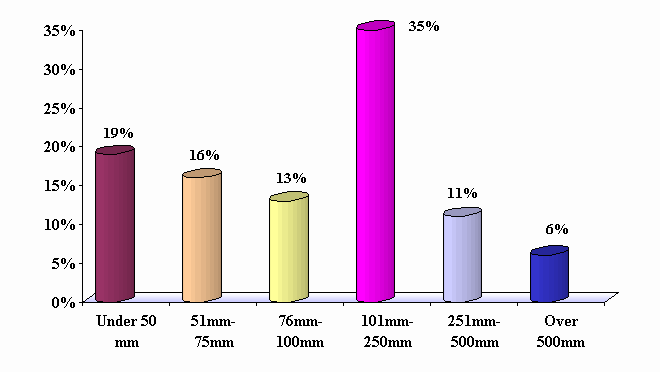
With geographical expansion possibilities present, the respondents were asked how many communities their bank served. Chart II (below) summarizes these findings. Over 80 percent of the respondents operated in the one-five community class. More than ten percent of the respondents operated in six or more communities.
CHART II
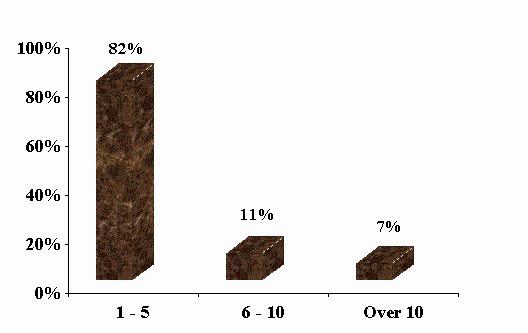
Chart III (below) provides information on the bank charter. Seventy-six percent of the respondents were state bank charters. Twenty-two percent of the respondents were national bank charters, with the remaining two percent having a federal savings bank charters.
CHART III
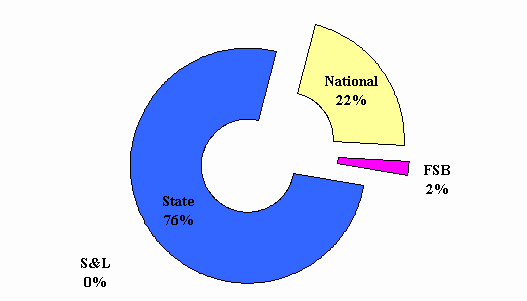
The information in Chart IV (below) shows that 83 percent of the respondents had a bank holding company in place. This suggested that most respondents were positioned to look at the opportunities created by the Act.
CHART IV
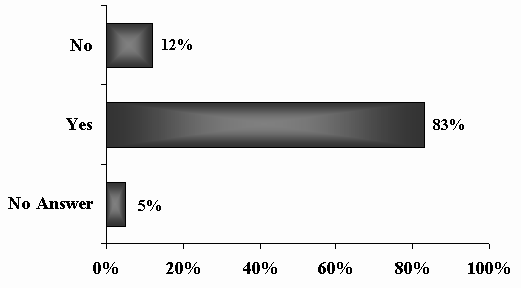
The data in Chart V (below) were particularly revealing, as the questions asked management what was being done regarding the new opportunities created by the Act. About one of five respondents were uninformed about the new opportunities of the Act. More than one-half the respondents were informed and educating their respective boards of directors about the new opportunities. Another 16 percent of the respondents were incorporating their business plans into the strategic planning sequence for the bank (or BHC). Finally, twelve percent of the respondents already had one or more new product or service opportunities underway.
CHART V
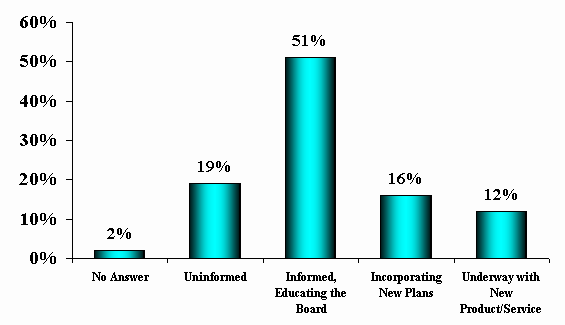
The data in Chart VI reveal how the new product and services planned were to be delivered. Nearly one-half the respondents plan to use the existing structure. Ten percent of the respondents planned to create a new operating subsidiary; another ten percent planned to create a new FHC. Seventeen percent though they would convert the existing BHC into a FHC.
CHART VI
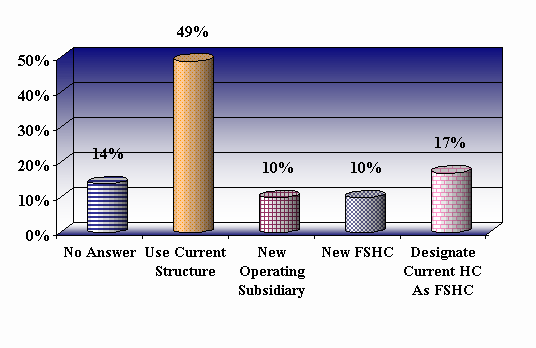
Insurance products, some securities products, and some real estate products were the new products and services favored by the community bankers. The remaining charts (below) show the findings of the survey by product type.
The data in Chart VII (below) focuses on the insurance business responses. Within the insurance area, three sub-type products were mentioned: underwriting, selling insurance, and selling annuities. Additionally, products were examined as to whether these were currently being offered, planned to be offered in a 1-3 year window, planned to be offered in a 4-5 year window, or there were no plans to offer.
CHART VII
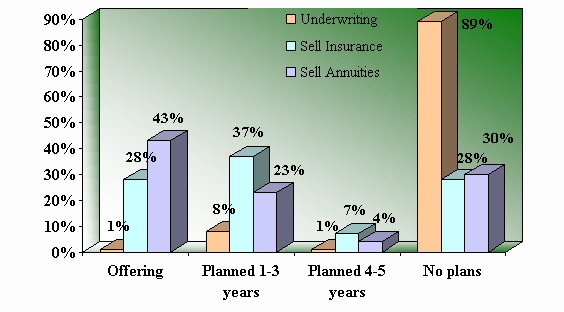
Generally, community bankers will stay away from insurance underwriting. Eighty-nine percent of the respondents had no plans for underwriting. The sale of insurance products was much different. Twenty-eight percent of the respondents were currently selling insurance products, with an additional 37 percent planning to offer these sales within three years. The sale of annuities was very similar. Forty-three percent of the respondents were currently selling annuities. with another 23 percent planning annuity sales within the next three years.
As a point of contrast, the information in Chart VIII (below) pertains to merchant banking opportunities. Within the merchant banking area, banks could either take equity positions or broker equity positions. Very few community bankers have plans to enter the area of merchant banking. In fact, as the chart shows, more than 90 percent of the respondents had no plans to take equity positions or broker equity positions. This finding is not surprising. Merchant banking is far outside the range of conventional products and services offered by community banks. Merchant banking is riskier. As per the Act, considerable bank capital is required for merchant banking activities. Apparently community bankers are more likely to deploy their capital for new opportunities more complementary to conventional bank products and services.
CHART VIII
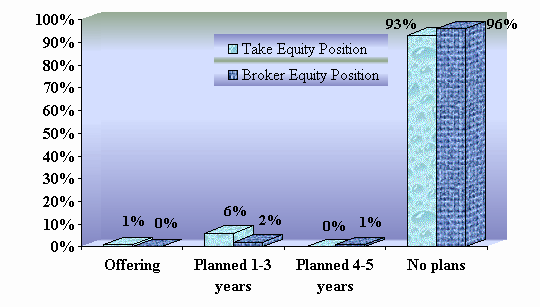
Real estate plans are noted in Chart IX. Four product/service options were identified under real estate: brokerage, appraisal, real estate development, and title insurance. The results revealed that very little is currently being offered in the real estate field. In contrast, within the 1-3 year period, 27 percent of the respondents intende to begin offering title insurance, and 17 percent intend to begin offering appraisal services. The numbers increase marginally for the 4-5 year planning period. Still, when the aggregate numbers are compared, between 58 percent and 85 percent of the respondents had no plans for any real estate product offerings.
CHART IX
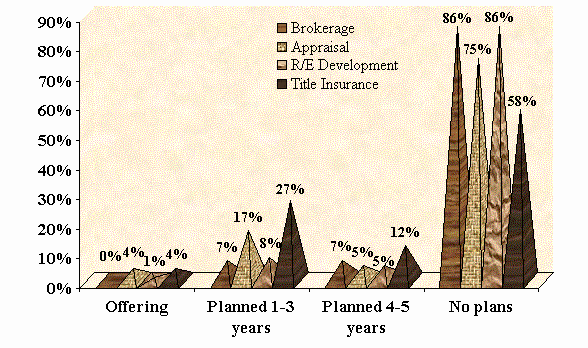
Since insurance products and securities products ranked the most popular new products for the community bankers, the respondents were questioned on how the products might be offered. The data in Chart X (below) identified third party vendor as the most popular means to offer both insurance products and annuity products. The respondents did indicate that trade associations and direct from an underwriter would be additional ways to offer insurance and annuity products.
CHART X
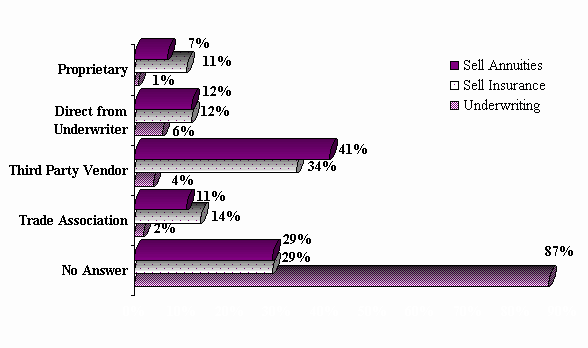
Chart XI (below) shows that selling equities and selling mutual funds were the community bankers' top choices for offerings of securities products. Most respondents favored a cooperative agreement with a third-party vendor as the preferred delivery method for equities and mutual fund products.
CHART XI
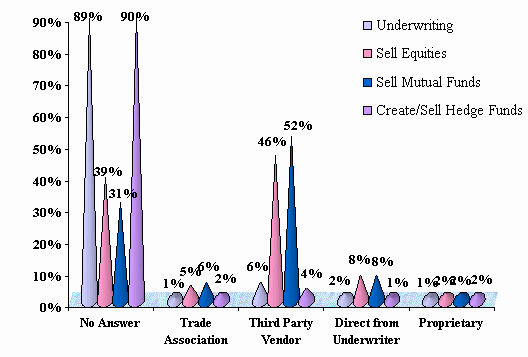
SUMMARY
These findings are the first to be gathered regarding community bankers plans following the passage of the Gramm-Leach-Bliley Act, 1999. While one-fifth of the bankers are not informed of the new product and service opportunities, the implication is that four-fifths are aware of some opportunities. Insurance sales, annuity sales, equity sales, and mutual fund sales are the most popular opportunities for immediate implementation. Most of the bankers intend to offer these products through a third party vendor.
Are community bankers very cautious about the offering of new products? Are community bankersí capital structures inadequate for capitalizing new ventures as a bank subsidiary or as part of the bank holding company? Are the regulatory consequences of new product and service offerings untested and, as a result, the cautious manager is hesitant to be the first to experiment? These questions need additional examination. Further field research is warranted to answer these questions.
ACKNOWLEDGEMENTS
The author acknowledges with appreciation the partial funding for this study that was received from The Fogelman College of Business and Economics, The University of Memphis. Thanks are due, too, for the considerable in kind assistance received from the Arkansas Community Banker Association, the Missouri Independent Bankers Association, and the Community Bankers Association of Indiana, Inc. Valuable data analysis and presentation assistance was provided by Pimkae Saisamorn.
REFERENCES